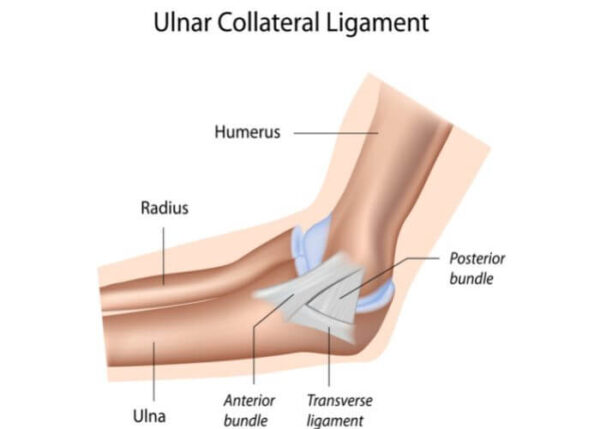UCL – MCL Injury Specialist

Are you an athlete or that participates in repetitive overhead motions like baseball, raquet sports or other throwing activities? If so, you may be at risk of sustaining an elbow injury to the ulnar collateral ligament, or UCL. Injury to the ULC or MCL ligament can cause elbow instability, pain and swelling. ULC/MCL specialist, Doctor Riley J. Williams provides diagnosis as well as surgical and nonsurgical treatment options for patients in Manhattan, Brooklyn, New York City and surrounding areas who have sustained an injury to the ULC or MCL in the elbow. Contact Dr. Williams’ team today!
What is an ulnar collateral ligament (UCL) injury?
The ulnar collateral ligament (UCL) is a band of thick, fibrous tissue, connecting the humerus (upper arm bone) to the ulna (forearm bone on the medial side). The UCL is also known as the medial collateral ligament (MCL). The UCL is responsible for elbow stability. The UCL is most commonly injured by repetitive overhead throwing or from a traumatic injury. A fall on an outstretched arm can injure the UCL and result in an unstable elbow. The ulnar collateral ligament is divided into three bands of tissue: posterior, anterior and transverse. Injuries to these structures can result in elbow pain, instability, and dysfunction. Dr. Riley J. Williams, orthopedic elbow specialist serving Manhattan, Brooklyn, New York City, NY and surrounding areas has extensive experience in treating ulnar collateral ligament injuries.

What are the symptoms of a UCL injury?
If the injury is chronic, daily tasks will most likely still be manageable. An acute injury will greatly limit functionality, especially if an elbow dislocation has occurred concomitantly. Individuals in the New York area often report the following symptoms for their UCL injury/tear:
- Elbow joint instability
- Pain on the inside of the elbow, exacerbated by overhead throwing
- Elbow swelling
- Weakness
- Popping sound (acute injury)
- Tingling sensation in the pinky finger
- Decreased velocity while throwing or serving
How is a UCL injury diagnosed?
Dr. Williams will discuss the patient’s history and symptoms. He will also perform a physical examination of the arm, elbow, and shoulder. The valgus stress test is a common method to determine elbow instability and to determine the degree of UCL injury.
Dr. Williams uses MRI to confirm and classify the UCL tear. Radiographs are also helpful to rule out related bone injuries. CT scans are sometimes used if severe bony abnormalities are suspected. If related ulnar nerve symptoms are suspected, an EMG and nerve conduction studies may be ordered to rule out cubital tunnel syndrome.
What are the grades of a ulnar collateral ligament (UCL) tear?
Ulnar collateral ligament tears are separated into grades, depending on the severity of the tear:
- Grade 1 tear: The ligament is strained, but not notably stretched. This grade causes pain, but the elbow still functions.
- Grade 2 tear: The ligament is stretched or partially torn, but still is attached at the native insertions on the humerus and ulna.
- Grade 3: The ligament is fully torn or ruptured.
How is a UCL injury treated?
Non-surgical treatment:
If a patient sustains a first or second-degree tear, Dr. Williams may recommend a conservative treatment option of RICE: rest, ice, compression and elevation of the elbow. NSAIDs, such as ibuprofen helps to mitigate pain and swelling. Other options may include splinting the elbow to help ensure rest and proper healing followed by physical therapy, which can strengthen the muscles around the ligament. Platelet rich plasma (blood spin procedure) injections can be of some value in treating partial UCL tears; usually multiple injections are indicated followed by a period of complete rest. In general, nonoperative treatment strategies are very unpredictable for UCL tears.
Surgical treatment:
If a complete or near-complete UCL tear occurs, surgical repair is recommended. Once the UCL is repaired, complete recovery takes approximately 9-12 months. Ulnar collateral reconstruction, also known as Tommy John Surgery, utilizes a tendon from another area in of the patient’s replace the native injured UCL. This procedure is effective at returning high demand athletes to sports.
For more information on a ULC injury and the treatment options available, please contact the office of Riley J. Williams, MD, orthopedic elbow specialist serving Manhattan, Brooklyn, New York City, NY and surrounding areas.